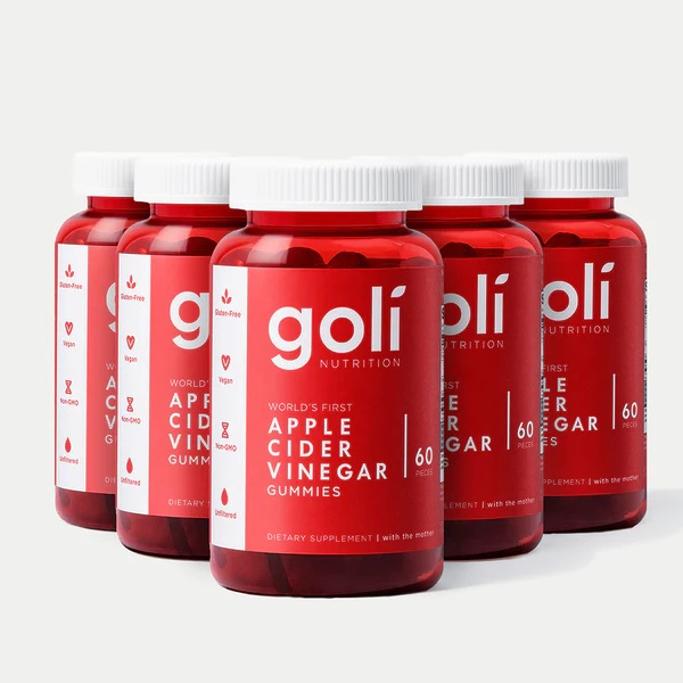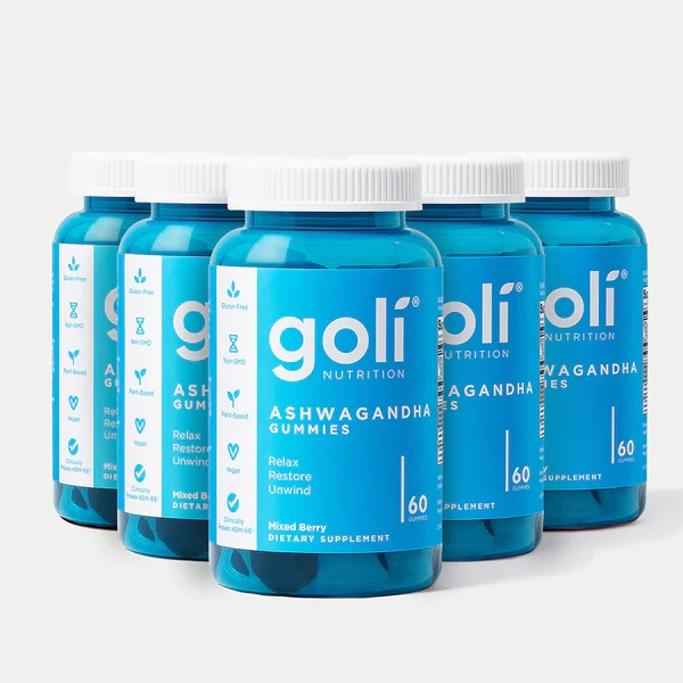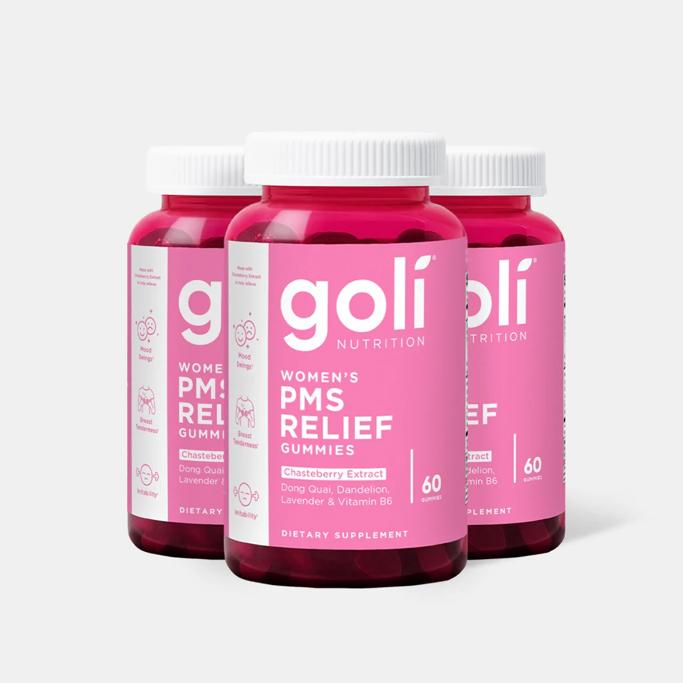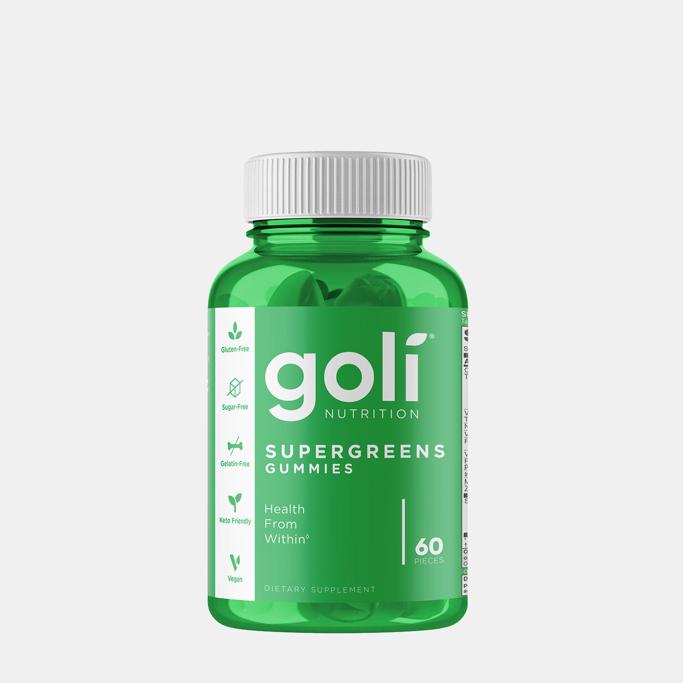Table of Contents
About Goli Gummies
“Happiness and wellness go hand in hand” — this is Goli’s core belief. And its mission is to ensure that you reach your nutrition goals and enjoy your daily supplements.
The brand is famous for its Apple Cider Vinegar Gummy, but they also have an array of other options for PMS, stress relief, and more. Keep reading to learn more about the ingredients and health benefits of Goli Gummies.
Goli Gummies Apple Cider Vinegar Gummies Ingredients

Goli Gummies Apple Cider Vinegar Gummies are a delicious and convenient way to support healthy digestion and overall wellness. Each gummy contains 500mg of apple cider vinegar, along with natural flavors and sweeteners. This vegan-friendly and gluten-free supplement can be enjoyed anytime, anywhere, and is an excellent alternative to traditional apple cider vinegar liquids or capsules.
Apple Cider Vinegar:
Apple cider vinegar is a type of vinegar made from fermented apples. It is rich in acetic acid, which has antimicrobial properties and may help improve digestion, blood sugar control, and skin health. It may also have a mild detoxifying effect on the body.
Beetroot
Beetroot is a root vegetable that is high in fiber, vitamins, and minerals. It is rich in antioxidants, including betalains, which have anti-inflammatory properties. Beetroot has been shown to improve blood pressure, exercise performance, and cognitive function.
Pomegranate:
Pomegranate is a fruit that is high in antioxidants, including polyphenols and flavonoids. It has anti-inflammatory properties and has been shown to improve heart health, lower blood pressure, and reduce inflammation.
Pectin:
Pectin is a type of soluble fiber that is found in fruits and vegetables. It may help lower cholesterol levels, regulate blood sugar, and promote digestive health.
Vitamin B12:
Vitamin B12 is a water-soluble vitamin that is essential for the proper functioning of the nervous system, DNA synthesis, and the production of red blood cells. It is found primarily in animal-based foods, and deficiency can lead to anemia and nerve damage.
Vitamin B9:
Vitamin B9, also known as folic acid or folate, is a water-soluble vitamin that is essential for the production of red blood cells and DNA synthesis. It is important for fetal development and may help reduce the risk of birth defects. It may also help reduce the risk of heart disease and certain types of cancer.
Goli Gummies Ashwa Gummies Ingredients

Goli Gummies Ashwa Gummies are a tasty and convenient way to support stress relief and relaxation. Each gummy contains 200mg of KSM-66 ashwagandha root extract, which is known for its adaptogenic properties and ability to help balance stress hormones. This vegan-friendly and gluten-free supplement is also infused with natural flavors and sweeteners, making it a delicious and easy way to incorporate ashwagandha into your daily wellness routine
KSM-66® Ashwagandha:
KSM-66® Ashwagandha is a type of adaptogenic herb that has been used for centuries in traditional Ayurvedic medicine to improve physical and mental health. It is derived from the roots of the Withania somnifera plant and is rich in compounds called withanolides, which are believed to be responsible for its health benefits. Some of the benefits associated with KSM-66® Ashwagandha include:
Stress reduction:
KSM-66® Ashwagandha has been shown to reduce the levels of cortisol, the hormone associated with stress, in the body.
Improved cognitive function:
Studies have found that KSM-66® Ashwagandha can improve memory, attention, and overall cognitive function.
Enhanced athletic performance:
KSM-66® Ashwagandha has been shown to improve endurance, strength, and muscle recovery in athletes.
Anti-inflammatory effects:
KSM-66® Ashwagandha has been shown to reduce inflammation in the body, which can help with a variety of conditions, including arthritis and autoimmune disorders.
Vitamin D:
Vitamin D is a fat-soluble vitamin that plays a critical role in many bodily functions. It is produced by the body when the skin is exposed to sunlight, but it can also be obtained through diet or supplements. Some of the benefits associated with Vitamin D include:
Strong bones:
Vitamin D helps the body absorb calcium, which is essential for strong bones and teeth.
Improved immune function:
Vitamin D helps regulate the immune system, and low levels of Vitamin D have been associated with an increased risk of infections.
Reduced risk of chronic diseases:
Adequate levels of Vitamin D have been associated with a lower risk of chronic diseases such as heart disease, diabetes, and multiple sclerosis.
Improved mood:
Some studies have found a link between low levels of Vitamin D and an increased risk of depression and anxiety.
Pectin:
Pectin is a type of soluble fiber that is found in many fruits and vegetables. It is often used as a thickener in jams and jellies but has also been shown to have numerous health benefits. Some of the benefits associated with pectin include:
Improved digestion
Pectin helps regulate bowel movements and can help relieve constipation.
Lowered cholesterol levels
Pectin can help lower LDL (bad) cholesterol levels in the blood.
Reduced risk of chronic diseases
Pectin has been associated with a lower risk of certain chronic diseases, including heart disease and diabetes.
Weight management
Pectin can help you feel full and satisfied after a meal, which may help with weight management.
Goli Gummies Women’s PMS Relief Ingredients

Goli Gummies Women’s PMS Relief is a supplement designed to help support women’s health during their menstrual cycle. Each gummy contains a blend of natural ingredients, including chaste tree berry, dong quai root, and lemon balm, which can help alleviate symptoms of PMS such as cramps, bloating, and mood swings. This vegan-friendly and gluten-free supplement is also infused with natural flavors and sweeteners, making it a delicious and easy way to support women’s health and well-being.
Chasteberry extract:
Chasteberry extract is derived from the fruit of the chaste tree and is also known as Vitex agnus-castus. It has been used for centuries in traditional medicine to regulate hormones and improve menstrual symptoms.
Some of the benefits associated with chasteberry extract include:
Regulation of menstrual cycles
Chasteberry extract can help regulate menstrual cycles and reduce symptoms such as cramping and breast tenderness.
Reduction of PMS symptoms
Chasteberry extract can help reduce symptoms of premenstrual syndrome (PMS), such as irritability, mood swings, and headaches.
Support for fertility
Chasteberry extract can help balance hormones and improve fertility in women.
Dong quai
Dong quai, also known as Angelica sinensis, is a root commonly used in traditional Chinese medicine to treat a variety of conditions. It is rich in compounds called coumarins, which are believed to have health benefits.
Some of the benefits associated with dong quai include:
Menopausal symptom relief
Dong quai has been shown to reduce hot flashes and other symptoms associated with menopause.
Pain relief
Dong quai has been used to alleviate menstrual cramps, headaches, and other types of pain.
Improved circulation
Dong quai can improve blood circulation and may help reduce the risk of cardiovascular disease.
Dandelion:
Dandelion is a plant that is often considered a weed but has numerous health benefits. It is rich in vitamins and minerals and has been used for centuries in traditional medicine.
Some of the benefits associated with dandelion include:
Improved digestion
Dandelion can help stimulate the digestive system and may help relieve constipation.
Reduced inflammation
Dandelion has anti-inflammatory properties and may help reduce inflammation in the body.
Support for liver health
Dandelion can help support liver function and may help detoxify the liver.
Antioxidant effects
Dandelion is rich in antioxidants, which can help protect the body from damage caused by free radicals.
Goli Gummies Supergreens Gummies Ingredients

Goli Gummies Supergreens Gummies are a delicious and convenient way to support overall health and wellness. Each gummy contains a blend of nutrient-rich superfoods, including spinach, spirulina, and wheatgrass, which are known for their antioxidant and anti-inflammatory properties.
This vegan-friendly and gluten-free supplement is also infused with natural flavors and sweeteners, making it a tasty and easy way to incorporate more greens into your daily diet. With its high-quality ingredients and potential health benefits, Goli Gummies Supergreens is a great addition to any wellness routine.
Artichoke Leaf Extract:
Artichoke leaf extract is derived from the leaves of the artichoke plant and has been used for centuries to support liver health and digestion.
Some of the benefits associated with artichoke leaf extract include:
Improved digestion
Artichoke leaf extract can help stimulate the production of bile, which aids in digestion and can help alleviate symptoms such as bloating and indigestion.
Liver support
Artichoke leaf extract contains compounds that can help protect the liver and support its function.
Cholesterol reduction
Artichoke leaf extract has been shown to help reduce cholesterol levels in the body.
Spinach
Spinach is a leafy green vegetable that is rich in nutrients and antioxidants. It is low in calories and high in fiber, making it a great addition to a healthy diet.
Some of the benefits associated with spinach include:
Improved eye health
Spinach contains high levels of lutein and zeaxanthin, which are antioxidants that can help protect the eyes from damage.
Reduced inflammation
Spinach contains anti-inflammatory compounds that can help reduce inflammation in the body.
Improved bone health
Spinach is rich in vitamin K, which is important for bone health and can help reduce the risk of fractures.
Celery
Celery is a crunchy vegetable that is low in calories and high in fiber. It is also a good source of antioxidants and other important nutrients.
Some of the benefits associated with celery include:
Reduced inflammation
Celery contains anti-inflammatory compounds that can help reduce inflammation in the body.
Improved digestion
Celery is high in fiber, which can help promote healthy digestion and reduce the risk of constipation.
Reduced blood pressure
Celery contains compounds that can help lower blood pressure.
Aloe Vera
Aloe vera is a plant that has been used for centuries for its medicinal properties. It is commonly used to soothe skin irritations, but it also has internal health benefits.
Some of the benefits associated with aloe vera include:
Improved digestion
Aloe vera can help soothe the digestive tract and reduce symptoms such as bloating and constipation.
Immune system support
Aloe vera contains compounds that can help support the immune system and reduce inflammation in the body.
Skin health
Aloe vera can help soothe and moisturize the skin, and may also help reduce the appearance of fine lines and wrinkles.
Broccoli:
Broccoli is a cruciferous vegetable that is rich in nutrients and antioxidants. It is low in calories and high in fiber, making it a great addition to a healthy diet.
Some of the benefits associated with broccoli include:
Cancer prevention
Broccoli contains compounds that can help protect against cancer.
Improved digestion
Broccoli is high in fiber, which can help promote healthy digestion and reduce the risk of constipation.
Heart health
Broccoli contains compounds that can help reduce inflammation and lower the risk of heart disease.
Parsley:
Parsley is an herb that is commonly used as a garnish, but it also has numerous health benefits. It is rich in vitamins and minerals and has been used in traditional medicine to treat a variety of conditions.
Some of the benefits associated with parsley include:
Improved digestion
Parsley can help stimulate the production of digestive enzymes and reduce symptoms such as bloating and indigestion.
Reduced inflammation
Parsley contains anti-inflammatory compounds that can help reduce inflammation in the body.
Improved bone health
Parsley is rich in vitamin K, which is important for bone health and can help reduce the risk of fractures.
Kale:
Kale is a leafy green vegetable that is low in calories and high in nutrients. It is rich in antioxidants and has been associated with numerous health benefits.
Some of the benefits associated with kale include:
Reduced inflammation
Kale contains anti-inflammatory compounds that can help reduce inflammation in the body.
Improved digestion
Kale is high in fiber, which can help promote healthy digestion and reduce the risk of constipation.
Improved bone health
Kale is rich in vitamin K, which is important for bone health and can help reduce the risk of fractures.
Vitamin A:
Vitamin A is a fat-soluble vitamin that is important for vision, immune function, and cell growth and differentiation.
Some of the benefits associated with vitamin A include:
Improved vision
Vitamin A is important for vision, and deficiency can lead to night blindness and other eye problems.
Immune system support
Vitamin A plays a role in immune function and can help protect against infections.
Skin health
Vitamin A can help promote healthy skin and may also help reduce the appearance of fine lines and wrinkles.
Vitamin B12:
Vitamin B12 is a water-soluble vitamin that is important for nervous system function, red blood cell production, and DNA synthesis.
Some of the benefits associated with vitamin B12 include:
Nervous system support
Vitamin B12 is important for nervous system function and can help prevent nerve damage.
Red blood cell production
Vitamin B12 is necessary for the production of red blood cells, which are important for carrying oxygen throughout the body.
Improved energy levels
Vitamin B12 plays a role in energy metabolism and can help improve energy levels.
Vitamin B6
Vitamin B6 is a water-soluble vitamin that is important for nervous system function, protein metabolism, and red blood cell production.
Some of the benefits associated with vitamin B6 include:
Nervous system support:
Vitamin B6 is important for nervous system function and can help prevent nerve damage.
Protein metabolism:
Vitamin B6 plays a role in protein metabolism and can help the body use protein more efficiently.
Mood regulation:
Vitamin B6 is involved in the synthesis of neurotransmitters, which can help regulate mood.
Thiamin:
Thiamin, also known as vitamin B1, is a water-soluble vitamin that is important for energy metabolism and nervous system function.
Some of the benefits associated with thiamin include:
Improved energy levels
Thiamin plays a role in energy metabolism and can help improve energy levels.
Nervous system support
Thiamin is important for nervous system function and can help prevent nerve damage.
Improved digestion
Thiamin can help stimulate the production of digestive enzymes and improve digestion.
Spirulina:
Spirulina is a type of blue-green algae that is rich in nutrients and antioxidants. It has been associated with numerous health benefits.
Some of the benefits associated with spirulina include:
Improved immune function
Spirulina contains compounds that can help support the immune system and reduce inflammation in the body.
Reduced cholesterol levels
Spirulina has been shown to help reduce cholesterol levels in the body.
Improved energy levels
Spirulina contains nutrients that can help improve energy levels and reduce fatigue.
References
Medically Cited: Our process involves examining medical research that has been published in reputable scientific journals, with the goal of upholding the highest possible standards of scientific accuracy.
Fact-Checked: To maintain quality, Repositive assigns a team of medical experts, including doctors and Registered Dietitians, to each article.
1. Fahey, R.L., Health benefits of apple cider vinegar and other common vinegars: A review. Integrative Medicine Alert, 2017. 20(6). https://www.proquest.com/docview/1985661237
2. Chen, L., et al., Beetroot as a functional food with huge health benefits: Antioxidant, antitumor, physical function, and chronic metabolomics activity. Food Science & Nutrition, 2021. 9(11): p. 6406-6420. https://onlinelibrary.wiley.com
3. Vučić, V., et al., Composition and potential health benefits of pomegranate: A review. Current Pharmaceutical Design, 2019. 25(16): p. 1817-1827. https://www.ingentaconnect.com/content
4. Blanco-Pérez, F., et al., The dietary fiber pectin: Health benefits and potential for the treatment of allergies by modulation of gut microbiota. Current Allergy and Asthma Reports, 2021. 21: p. 1-19. https://link.springer.com/article
5. Stover, P.J., Physiology of folate and vitamin B 12 in health and disease. Nutrition Reviews, 2004. 62(suppl_1): p. S3-S12. https://academic.oup.com
6. Mironenko, A. and T. Eliseeva, Vitamin B9–description, benefits, effects on the body and best sources. Journal of Healthy Nutrition and Dietetics, 2019. 4(10): p. 88-100. https://cyberleninka.ru
7. Gupta, S., et al., Ashwagandha (Withania somnifera)–a herb with versatile medicinal properties empowering human physical and mental health. Journal of Pre-Clinical and Clinical Research, 2021. 15(3): p. 129-133. https://www.jpccr.eu
8. Speers, A.B., et al., Effects of withania somnifera (ashwagandha) on stress and the stress-related neuropsychiatric disorders anxiety, depression, and insomnia. Current Neuropharmacology, 2021. 19(9): p. 1468. https://www.ncbi.nlm.nih.gov
9. Gopukumar, K., et al., Efficacy and safety of ashwagandha root extract on cognitive functions in healthy, stressed adults: A randomized, double-blind, placebo-controlled study. Evidence-Based Complementary and Alternative Medicine, 2021. 2021. https://www.hindawi.com/journals
10. Choudhary, B., A. Shetty, and D.G. Langade, Efficacy of Ashwagandha (Withania somnifera [L.] Dunal) in improving cardiorespiratory endurance in healthy athletic adults. AYU (An international Quarterly Journal of Research in Ayurveda), 2015. 36(1): p. 63. https://ayujournal.org/article
11. Chandra, S., et al., Evaluation of anti-inflammatory effect of ashwagandha: A preliminary study in vitro. Pharmacognosy Journal, 2012. 4(29): p. 47-49. https://www.sciencedirect.com/science
12. Holick, M.F., Evolution and function of vitamin D, in Vitamin D analogs in cancer prevention and therapy, J. Reichrath, W. Tilgen, and M. Friedrich, Editors. 2003, Springer: Berlin, Heidelberg. p. 3-28. https://link.springer.com/chapter
13. Tanner, S.B. and S.A. Harwell, More than healthy bones: A review of vitamin D in muscle health. Therapeutic Advances in Musculoskeletal Disease, 2015. 7(4): p. 152-159. https://journals.sagepub.com
14. Hewison, M., Vitamin D and immune function: An overview. Proceedings of the Nutrition Society, 2012. 71(1): p. 50-61. https://www.cambridge.org/core/journals
15. Muscogiuri, G., et al., Vitamin D and chronic diseases: The current state of the art. Archives of Toxicology, 2017. 91: p. 97-107. https://link.springer.com/article
16. Wang, Y., et al., Effects of vitamin C and vitamin D administration on mood and distress in acutely hospitalized patients. The American Journal of Clinical Nutrition, 2013. 98(3): p. 705-711. https://academic.oup.com
17. Ghai, K., A. Gupta, and P. Gupta, Pectin: A versatile biopolymer with numerous health benefits and medical uses. Journal of Biologically Active Products from Nature, 2012. 2(4): p. 250-255. https://www.tandfonline.com
18. Haider, K. and P. Wilde, Digestion and metabolism of pectin. Pectin: Technological and Physiological Properties, 2020: p. 149-164. https://link.springer.com
19. Hillman, L.C., et al., The effects of the fiber components pectin, cellulose and lignin on serum cholesterol levels. The American Journal of Clinical Nutrition, 1985. 42(2): p. 207-213. https://academic.oup.com/ajcn/article
20. Wu, C., et al., Low methoxyl pectin protects against autoimmune diabetes and associated caecal dysfunction. Molecular Nutrition & Food Research, 2019. 63(21): p. 1900307. https://onlinelibrary.wiley.com
21. Adam, C.L., et al., Effects of dietary fibre (pectin) and/or increased protein (casein or pea) on satiety, body weight, adiposity and caecal fermentation in high fat diet-induced obese rats. PloS One, 2016. 11(5): p. e0155871. https://journals.plos.org
22. Huddleston, M. and E.A. Jackson, Is an extract of the fruit of agnus castus (chaste tree or chasteberry) effective for prevention of symptoms of premenstrual syndrome (PMS)? Journal of Family Practice, 2001. 50(4): p. 298. https://go.gale.com
23. Reiser, E., et al., Non-Hormonal treatment options for regulation of menstrual cycle in adolescents with PCOS. Journal of Clinical Medicine, 2023. 12(1): p. 67. https://www.mdpi.com
24. Seidlova-Wuttke, D. and W. Wuttke, The premenstrual syndrome, premenstrual mastodynia, fibrocystic mastopathy and infertility have often common roots: Effects of extracts of chasteberry (Vitex agnus castus) as a solution. Clinical Phytoscience, 2017. 3: p. 1-11. https://link.springer.com/article
25. Westphal, L.M., et al., A nutritional supplement for improving fertility in women. Journal of Reproductive Medicine, 2004. 49(4): p. 289-93. https://www.reproductivewellness.com
26. DeRosa, R. and M.J. Cupp, Dong quai. Toxicology and Clinical Pharmacology of Herbal Products, 2000: p. 289-294. https://link.springer.com
27. Lau, C.B., et al., Use of dong quai (Angelica sinensis) to treat peri-or postmenopausal symptoms in women with breast cancer: Is it appropriate? Menopause, 2005. 12(6): p. 734-740. https://journals.lww.com
28. Bain, D., Pharmacological and biochemical action of Angelica sinensis (Dong Quai): Natural product with therapeutic potential. International Journal of Recent Research in Life Sciences, 2015. 2(3): p. 8-23. https://www.paperpublications.org
29. Goh, S. and K. Loh, Gynaecomastia and the herbal tonic “Dong Quai”. Singapore Medical Journal, 2001. 42(3): p. 115-116. https://www.researchgate.net
30. Maggi, F., Dandelion, in Nonvitamin and nonmineral nutritional supplements. 2019, Elsevier. p. 203-204. https://www.sciencedirect.com/science
31. Li, Y., Y. Chen, and D. Sun-Waterhouse, The potential of dandelion in the fight against gastrointestinal diseases: A review. Journal of Ethnopharmacology, 2022. 293: p. 115272. https://www.sciencedirect.com/science
32. Mahboubi, M. and M. Mahboubi, Hepatoprotection by dandelion (Taraxacum officinale) and mechanisms. Asian Pacific Journal of Tropical Biomedicine, 2020. 10(1): p. 1. https://apjtb.org/article
33. Al-Malki, A.L., et al., Hepatoprotective effect of dandelion (Taraxacum officinale) against induced chronic liver cirrhosis. Journal of Medicinal Plants Research, 2013. 7: p. 1494-505. https://academicjournals.org/article
34. Wang, L., et al., Characterization, antioxidant and immunomodulatory effects of selenized polysaccharides from dandelion roots. Carbohydrate Polymers, 2021. 260: p. 117796. https://www.sciencedirect.com/science
35. Salem, M.B., et al., Pharmacological studies of artichoke leaf extract and their health benefits. Plant Foods for Human Nutrition, 2015. 70: p. 441-453. https://pharmadel.info/wp-content
36. Guven, O., et al., Food processing and digestion: The effect of extrusion process on bioactive compounds in extrudates with artichoke leaf powder and resulting in vitro cynarin and cynaroside bioaccessibility. LWT, 2018. 90: p. 232-237. https://www.sciencedirect.com/science
37. Panahi, Y., et al., Efficacy of artichoke leaf extract in non‐alcoholic fatty liver disease: A pilot double‐blind randomized controlled trial. Phytotherapy Research, 2018. 32(7): p. 1382-1387. https://onlinelibrary.wiley.com
38. Wider, B., et al., Artichoke leaf extract for treating hypercholesterolaemia. Cochrane Database of Systematic Reviews, 2013(3). https://www.cochranelibrary.com
39. Singh, J., G. Jayaprakasha, and B.S. Patil, Extraction, identification, and potential health benefits of spinach flavonoids: A review. Advances in Plant Phenolics: From Chemistry to Human Health, 2018: p. 107-136. https://pubs.acs.org
40. Chovifah Ramadhana, E., Research and development final project “vegetable sausage from Turi flower and water spinach for eyes health”. 2019, Ottimmo International. http://repository.ottimmo.ac.id/252/
41. Beaupré, V., N. Boucher, and I. Desgagné-Penix, Thykamine extracts from Spinach reduce acute inflammation in vivo and downregulate phlogogenic functions of human blood neutrophils in vitro. Biomedicines, 2020. 8(7): p. 219. https://www.mdpi.com
42. Karpouzos, A., et al., Nutritional aspects of bone health and fracture healing. Journal of Osteoporosis, 2017. 2017. https://www.hindawi.com/journals
43. Sowbhagya, H., Chemistry, technology, and nutraceutical functions of celery (Apium graveolens L.): An overview. Critical Reviews in Food Science and Nutrition, 2014. 54(3): p. 389-398. https://www.tandfonline.com
44. Lewis, D.A., S.M. Tharib, and G.B.A. Veitch, The anti-inflammatory activity of celery Apium graveolens L.(Fam. Umbelliferae). International Journal of Crude Drug Research, 1985. 23(1): p. 27-32. https://www.tandfonline.com
45. Gianessi, L., The Benefits of Insecticide Use: Celery. 2009, Crop Protection Research Institute. https://citeseerx.ist.psu.edu
46. Illes, J.D., Blood pressure change after celery juice ingestion in a hypertensive elderly male. Journal of Chiropractic Medicine, 2021. 20(2): p. 90-94. https://www.sciencedirect.com/science
47. Surjushe, A., R. Vasani, and D. Saple, Aloe vera: A short review. Indian Journal of Dermatology, 2008. 53(4): p. 163. https://www.ncbi.nlm.nih.gov
48. Sadgrove, N.J. and M.S. Simmonds, Pharmacodynamics of Aloe vera and acemannan in therapeutic applications for skin, digestion, and immunomodulation. Phytotherapy Research, 2021. 35(12): p. 6572-6584. https://onlinelibrary.wiley.com
49. Christaki, E.V. and P.C. Florou-Paneri, Aloe vera: A plant for many uses. Journal of Food, Agriculture and Environment, 2010. 8(2): p. 245-249. https://www.rimedidelfarmacista.it
50. Liang, J., et al., Aloe vera: A medicinal plant used in skin wound healing. Tissue Engineering Part B: Reviews, 2021. 27(5): p. 455-474. https://www.liebertpub.com
51. Jeffery, E., et al., Variation in content of bioactive components in broccoli. Journal of Food Composition and Analysis, 2003. 16(3): p. 323-330. https://www.sciencedirect.com/science/article/abs/pii/S0889157503000450
52. Kaiser, A.E., et al., Sulforaphane: A broccoli bioactive phytocompound with cancer preventive potential. Cancers, 2021. 13(19): p. 4796. https://www.mdpi.com/2072-6694/13/19/4796
53. Rychlik, J., et al., Antioxidant capacity of broccoli sprouts subjected to gastrointestinal digestion. Journal of the Science of Food and Agriculture, 2015. 95(9): p. 1892-1902. https://onlinelibrary.wiley.com
54. Pereyra, K.V., et al., Dietary supplementation of a sulforaphane-enriched broccoli extract protects the heart from acute cardiac stress. Journal of Functional Foods, 2020. 75: p. 104267. https://www.sciencedirect.com/science
55. Charles, D., Parsley, in Handbook of Herbs and Spices. 2012, Elsevier. p. 430-451. https://www.sciencedirect.com/science
56. Farzaei, M.H., et al., Parsley: A review of ethnopharmacology, phytochemistry and biological activities. Journal of Traditional Chinese Medicine, 2013. 33(6): p. 815-826. https://www.sciencedirect.com/science
57. Slighoua, M., et al., Assessment of in vivo estrogenic and anti-inflammatory activities of the hydro-ethanolic extract and polyphenolic fraction of parsley (Petroselinum sativum Hoffm.). Journal of Ethnopharmacology, 2021. 265: p. 113290. https://www.sciencedirect.com/science
58. Putnam, S.E., et al., Natural products as alternative treatments for metabolic bone disorders and for maintenance of bone health. Phytotherapy Research, 2007. 21(2): p. 99-112. https://onlinelibrary.wiley.com
59. Satheesh, N. and S. Workneh Fanta, Kale: Review on nutritional composition, bio-active compounds, anti-nutritional factors, health beneficial properties and value-added products. Cogent Food & Agriculture, 2020. 6(1): p. 1811048. https://www.tandfonline.com
60. Alfawaz, H.A., et al., Awareness, knowledge and attitude towards ‘Superfood’Kale and Its health benefits among Arab adults. Nutrients, 2022. 14(2): p. 245. https://www.mdpi.com
61. Yang, I., G.K. Jayaprakasha, and B. Patil, In vitro digestion with bile acids enhances the bioaccessibility of kale polyphenols. Food & Function, 2018. 9(2): p. 1235-1244. https://pubs.rsc.org
62. Chen, Y.-m., S.C. Ho, and J.L. Woo, Greater fruit and vegetable intake is associated with increased bone mass among postmenopausal Chinese women. British Journal of Nutrition, 2006. 96(4): p. 745-751. https://www.cambridge.org
63. Olson, J.A., Benefits and liabilities of vitamin A and carotenoids. The Journal of Nutrition, 1996. 126(suppl_4): p. 1208S-1212S. https://academic.oup.com
64. Faustino, J.F., et al., Vitamin A and the eye: An old tale for modern times. Arquivos Brasileiros de Oftalmologia, 2016. 79: p. 56-61. https://www.scielo.br
65. Huang, Z., et al., Role of vitamin A in the immune system. Journal of Clinical Medicine, 2018. 7(9): p. 258. https://www.mdpi.com
66. Schröder, J.-M., Seeing is believing: Vitamin A promotes skin health through a host-derived antibiotic. Cell Host & Microbe, 2019. 25(6): p. 769-770. https://www.sciencedirect.com/science
67. Smith, A.D., M.J. Warren, and H. Refsum, Vitamin B12. Advances in Food and Nutrition Research, 2018. 83: p. 215-279. https://www.sciencedirect.com/science
68. Scott, J.M., Folate–vitamin B12 interrelationships in the central nervous system. Proceedings of the Nutrition Society, 1992. 51(2): p. 219-224. https://www.cambridge.org
69. Fenech, M., The role of folic acid and vitamin B12 in genomic stability of human cells. Mutation Research/Fundamental and Molecular Mechanisms of Mutagenesis, 2001. 475(1-2): p. 57-67. https://www.sciencedirect.com/science
70. Romain, M., et al., The role of vitamin B12 in the critically ill—a review. Anaesthesia and Intensive Care, 2016. 44(4): p. 447-452. https://journals.sagepub.com
71. Institute of Medicine (US) Standing Committee, Dietary reference intakes for thiamin, riboflavin, niacin, vitamin B6, folate, vitamin B12, pantothenic acid, biotin, and choline. 1998: National Academies Press. https://www.ncbi.nlm.nih.gov
72. Spector, R., Vitamin B6 transport in the central nervous system: In vivo studies. Journal of Neurochemistry, 1978. 30(4): p. 881-887. https://onlinelibrary.wiley.com
73. Parra, M., S. Stahl, and H. Hellmann, Vitamin B6 and its role in cell metabolism and physiology. Cells, 2018. 7(7): p. 84. https://www.mdpi.com
74. Malouf, R., et al., Vitamin B6 for cognition. Cochrane Database of Systematic Reviews, 1996. 2010(1). https://www.cochranelibrary.com
75. Lonsdale, D., Thiamin. Advances in Food and Nutrition Research, 2018. 83: p. 1-56. https://www.sciencedirect.com/science
76. Lonsdale, D., A review of the biochemistry, metabolism and clinical benefits of thiamin (e) and its derivatives. Evidence-Based Complementary and Alternative Medicine, 2006. 3(1): p. 49-59. https://www.hindawi.com
77. Lonsdale, D., Thiamin (e): The spark of life. Water Soluble Vitamins: Clinical Research and Future Application, 2011: p. 199-227. https://link.springer.com
78. Frank, L.L., Thiamin in clinical practice. Journal of Parenteral and Enteral Nutrition, 2015. 39(5): p. 503-520. https://aspenjournals.onlinelibrary.wiley.com
79. Ali, S.K. and A.M. Saleh, Spirulina-an overview. International Journal of Pharmacy and Pharmaceutical Sciences, 2012. 4(3): p. 9-15. https://www.semanticscholar.org
80. Selmi, C., et al., The effects of Spirulina on anemia and immune function in senior citizens. Cellular & Molecular Immunology, 2011. 8(3): p. 248-254. https://www.nature.com/articles/cmi201076
81. Deng, R. and T.J. Chow, Hypolipidemic, antioxidant, and antiinflammatory activities of microalgae Spirulina. Cardiovascular Therapeutics, 2010. 28(4): p. e33-e45. https://onlinelibrary.wiley.com
82. Kumari, D.J., et al., Potential health benefits of Spirulina platensis. International Journal of Advanced Pharmaceutical Sciences, 2011. 2: p. 417-422. https://www.researchgate.net

Leave a Reply